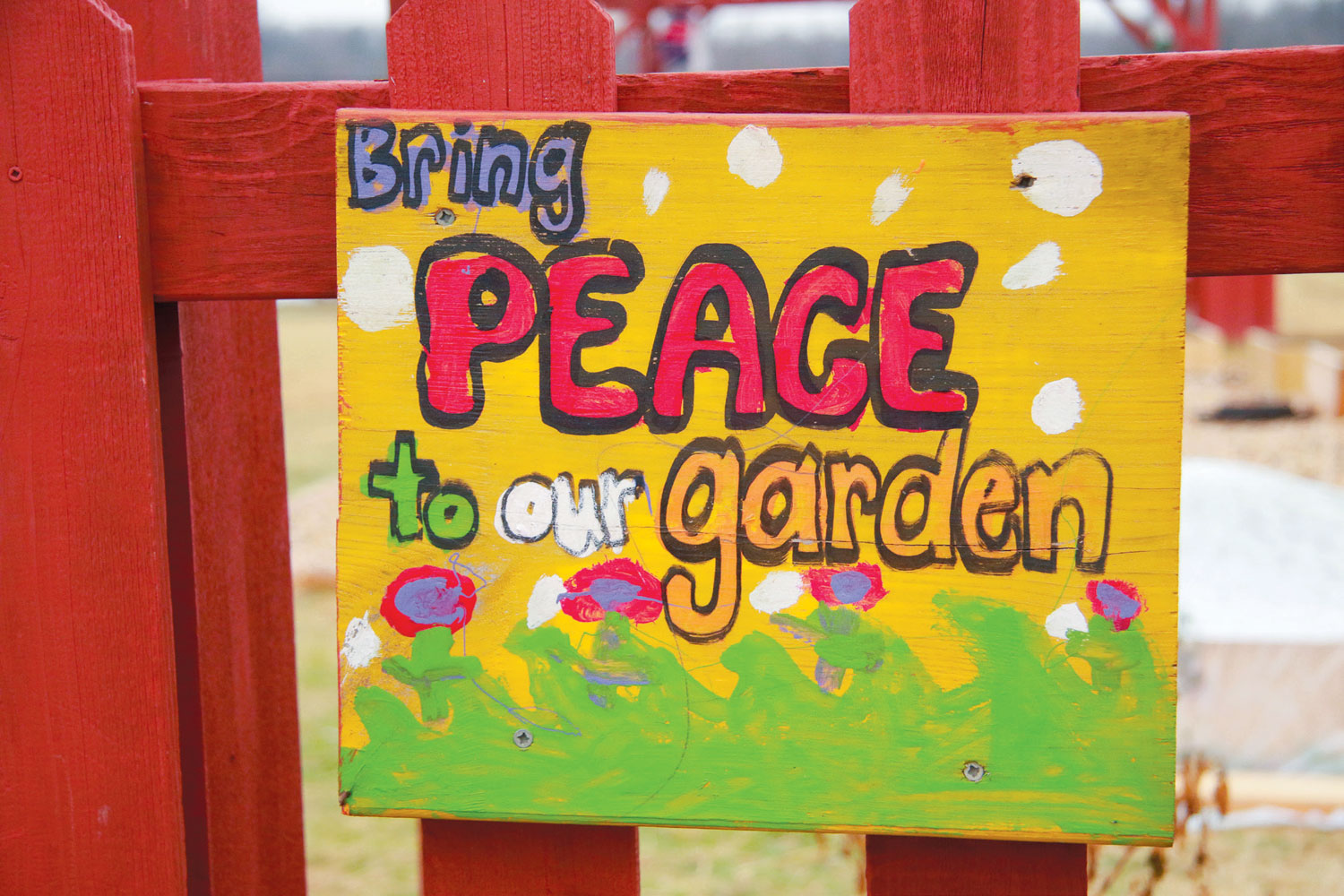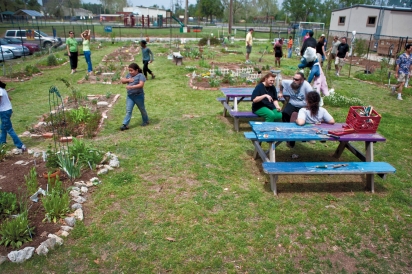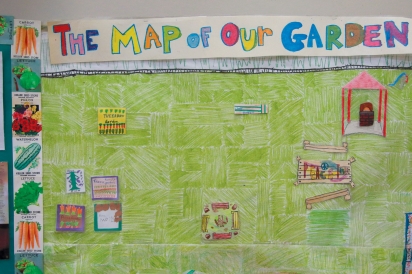Labor of Lunch: Global Gardens
GIVE PEAS A CHANCE
Seeds of change are in the ground (along with peas, herbs, tomatoes, lettuce and the like), and gardens will soon be popping up across the city. But instead of overall-clad farmers, dozens of school children in Tulsa and the surrounding suburbs will care for and harvest these plots—all of which are growing within the gates of Global Gardens.
Global Gardens is a nonprofit organization whose main objective it to empower students and communities through hands-on science education. But really, what is Global Gardens? Proof that one person truly can make a difference in the lives of countless others.
That person, Tulsa native Heather Oakley, Global Gardens’ founder and director, left Oklahoma for graduate school at Columbia after achieving a double major in botany and French at the University of Oklahoma. Before her degree plan started, however, Oakley lived in France and then East Africa, learning, teaching and experiencing life abroad.
While at Columbia, where she earned master’s degrees in both urban science education and international development/peace education, she consulted with local elementary school teachers about how to better teach science. She also taught at the UN International School, where she saw the concept of peace education in action, and in Harlem, where she taught science for first through sixth graders and piloted two small-scale community garden projects.
“Grow yourself as you grow your garden. We garden because it’s fun and it’s also a way to bring people together because gardening is a team effort. We don’t do it all through just gardening either, but also through researching, building, cooking and even teaching each other.”
—Josh, 7th grade
When Oakley returned to Tulsa in 2006, she brought a dream to create a program that would utilize all of her diverse experience in botany, peace education and community organization—a program that would empower high-risk students to become seeds of change in their own communities.
The area that was to become Global Gardens was tilled in the spring of 2007 at Eugene Field Elementary School after Oakley pitched her idea to the administration, teachers and students. After receiving their full support, they put down roots in the ground behind the school. The dozen or so garden plots are all planted, tended and harvested by the children—each classroom has its own garden (with a theme chosen collectively by the class) and each student in the after-school program has the opportunity to earn his or her own garden.
“I like Global Gardens because the people fill me with joy.”
—Mikey, 5th grade
For the teachers in the Global Gardens program, a garden is more than a pretty green space ripe with fruits and vegetables—it is powerful learning tool, as essential to a student’s learning process as a computer or a microscope.
On a typical school day, the Global Gardens teachers spend time in the classroom, meeting with each class to develop their garden and to plan how best to use it to grow food. Each participating classroom has a specific theme for its garden, which is decided collectively by the class. In the past, themes have ranged from taco gardens to “roots and fruits” to “fire and ice,” a creative moniker for a garden featuring everything from iceberg lettuce to jalapeño peppers.
In addition to growing and harvesting food, the students use the garden as a catalyst for art projects, building projects (they’ve built raised beds, cob ovens and more) and literacy projects. Last year the “folk tale garden” class all authored and illustrated their own folk tales about their plants … think “Princess and the Pea.”
“Global Gardens makes me feel like a seed sprouting into a flower.”
—Miriam, 3rd grade
The after-school program is focused more on leadership and personal student development. Students must earn their gardens—they meet daily with after-school educators to plant, cook, create art in the garden and much more. Along with earning their gardens, the students’ interests help determine bigger projects, which have included creating and participating in farmers’ markets, developing fundraisers and other community events like Bike for a Life—a city-wide bike ride that raised over $17,000 in its three-year run. The proceeds were donated to charities researched and agreed upon by the children, including the Alzheimer’s Association.
Currently, Global Gardens serves over 1,300 students, pre-K through seventh grade, at three Tulsa schools with during-school, after- school and summer programs. The family- based community gardens are actively tended by around 50 adults in the district.
According to the National Gardening Association, 35% of all households in America, or 42 million households, are growing food at home or in a community garden, up 17% in five years. There has most definitely been a significant shift towards growing food both at home and in school gardens.
“This report clearly shows that there truly is a food revolution taking place in America,” says Mike Metallo, president and CEO of the National Gardening Association. “We are seeing more people, particularly young people, actively engaged in growing their own food. The growth in just five years is pretty spectacular.”
As the nation’s leading nonprofit in gardening education, the National Gardening Association has published annual statistics on food gardening in America since 1978. The NGA credits the rise in food gardening to several things: an improving economy; strong national leadership, including the launch of the “Let’s Move” initiative and White House Kitchen Garden by First Lady Michelle Obama; action by federal agencies such as the U.S. Department of Agriculture and the U.S. Department of Health and Human Services to increase awareness and educational efforts toward food gardening; and more engagement and public-private partnerships through organizations like the National Gardening Association, to promote and build food gardens in communities across the country.
But this is not a story about gardening … or politics, for that matter. It is about children getting engaged, in a way we haven’t seen too frequently in the public school systems. School gardening engages students by providing a dynamic environment to observe, discover, experiment, nurture and learn. Some of the benefits, compiled by the staff at NGA, include a significant increase in science achievement scores, improved social skills and behavior, increased preference of vegetables and knowledge of nutrition, and an instilled appreciation and respect for nature that lasts into adulthood. Ideas that could—and should—spread like a windblown dandelion throughout the country.
Planting for all of the Global Gardens plots starts the first of March, and with the program at Eugene Fields kicking off its ninth year, more plans are in the works. Global Gardens is going strong at Rosa Parks Elementary, the Middle School Community Garden for sixth and seventh graders on the grounds of Asbury Methodist Church. A new program launched this winter at McAuliffe Elementary—part of the Union Public School system, as are the other Global Garden sites.
Oakley has grand plans to spread as an organization, with the hopes of becoming a role model for other schools. In contrast to the Edible Schoolyard project, Global Garden’s initiative is to be child-led as opposed to program-led.
“Our goal is empowerment. We have dreams of helping kids escape the poverty cycle by teaching them problem solving and helping them navigate life,” Oakley says. “We want to teach them how to set goals and work towards them, using the scientific method in problem solving. Kids then have choices in their navigation.”
Oakley also touches on the concept of peace education, half of her dual master’s degree.
“It involves using education to cultivate a culture of peace and integration—how to work together successfully as adults, celebrating each other’s successes. A child-led philosophy is so effective because the kids are so invested—if they plant the seeds, water, sprout, grow and harvest their plants, they will eat anything!”
School-based gardening is not a new concept, nor is it limited to rural communities. With a quick internet search, dozens of organizations pop up, all with the same mission—to get kids in the garden, no matter where they live.
“Global Gardens is fun and peaceful. We can grow amazing things.”
—Nevaeh, 3rd grade
Urban Sprouts, a San Francisco–based program, supports school gardens at five schools in the San Francisco Unified School District. Similarly, the Collective School Garden Network has the mission to place and sustain an edible garden in every willing school in Arizona and California, from urban pockets to vast rural districts. And they are well on their way—hundreds of schools have already received grants for implementing the garden plots.
These gardens, as well as the thousands across the country, aren’t perfectly manicured or always ripe with successful plantings, but they are changing the lives of those that tend them. Quite literally, food for thought.








